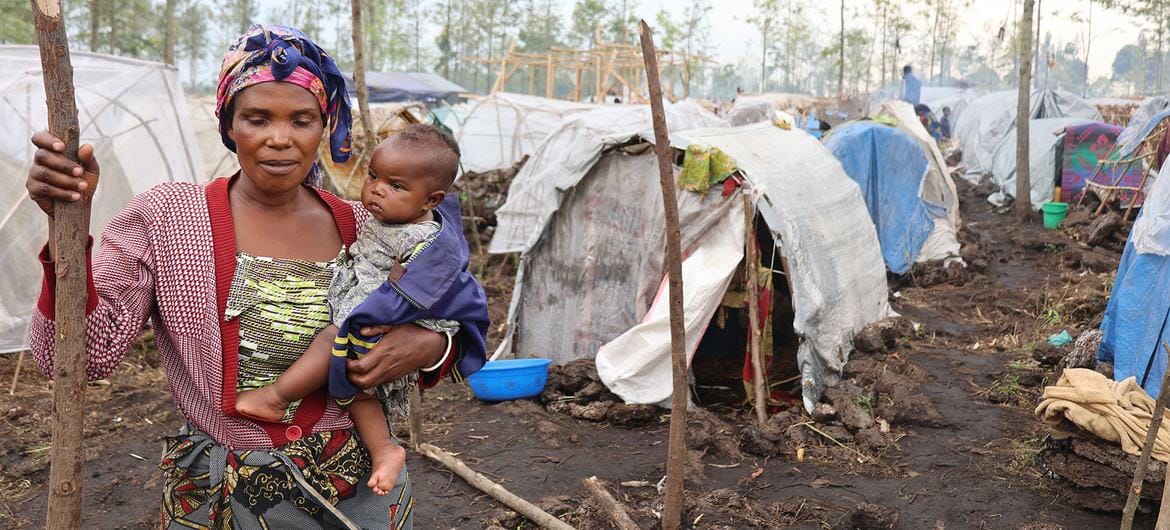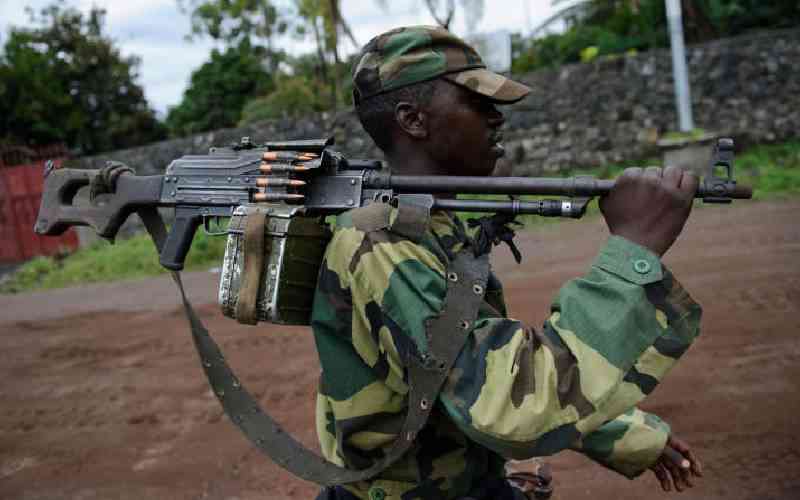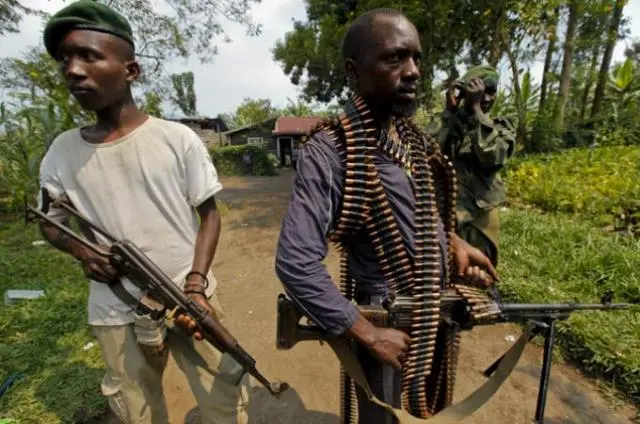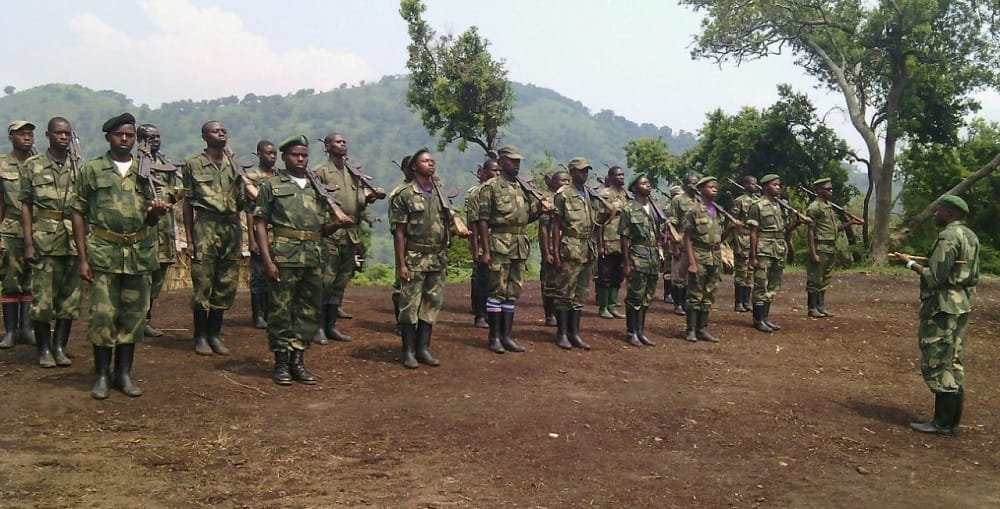The case of Sake: the defense line around Goma is a criminal construction in which all the basic rules of the Geneva Convention are violated. Welcome to hell!

The war between the M23 and the Congolese army with its allies is slumbering on and the same thing can be said about the ongoing negotiations to solve this conflict. Nobody seems to know the way out of this deep snake pit of contradictions, corrupt practices, lies, blatant racism and genocidal practices. People here do not believe any longer in a peaceful solution: the peace negotiations in Angola might offer some hope but this same hope is overshadowed by criminal practices on the battlefield. And all this is happening under the watchful eyes of the international community. During the last couple of weeks, we contacted several people on the spot, we double checked the info they gave us with others. We already knew that the situation on the field had worsen, but some of the details we were able to dig up shocked us deeply. We will focus on the situation in and around Sake, a strategic satellite town of Goma that will be (very likely) used as a staging point for a new FARDC offensive against the M23 rebels who control the higher ground and the hills in this area and who control the road between Sake and Bukavu.

The Goma-Mugunga-Sake Road is the only way out of Goma. If the airport is blocked, Goma can only be fed via the Kivu Lake and the road beside that lake that connects Goma with Bukavu. This facility is only possible because the M23 allows trucks to pass. Most of the external observers understand that the FARDC coalition cannot succeed to chase the M23 from the surrounding hills, and that in case of a counterattack Goma might fall. At that point, the situation might really get dirty: officially, the Congolese army still protects the province capitol. But practically, only the Burundian army and the Imbonerakure, Congolese army and militias and Rwandan Hutu extremists are the ones running this show. Different etiquettes are used to camouflage this construction. The most common one is the concept of the ‘wazalendo’, a name that was initially given to local youngsters who were mobilized to fight, what they call "Tutsi aggressors". A lot of these were already killed in previous battles and others fled the battlefield to IDP camps and the suburbs of Goma where they now are engaged in robberies and plenty of other criminal activities. The Congolese government via FARDC distributed thousands of machine guns in the region and it has already become impossible to control how these tools are used and who is now using them. On the other hand, the FARDC incorporated hundreds of FDLR, the Rwandan Hutu extremists into their ranks. Add to those another couple of thousands of Burundian ‘Imbonerakure’ who are also active in this region and who are now also dressed up in FARDC fatigues. The Imbonerakure are the Burundian equivalent of the Rwandan FDLR or the so called ‘Interahamwe’, Hutu radicals with bloody CV’s who killed thousands of innocent people in the past. Together with the other proxy radical group of Congolese origin(the Nyatura), and some local mercenary Mayi Mayi groups, these irregulars now control the city of Sake and its surroundings. They loot, kill, rape at will, and the Imbonerakure are boosting openly in local bars that being present in Sake is a very lucrative activity for them. They also receive the protection of the Burundian army that is fighting side by side with the FARDC. On the spot, these militias are closely collaborating with the FARDC. The Imbonerakure and the FDLR have now the monopoly on all the check points on the way to Bukavu and to Masisi. Two years ago, the big coltan mine of Rubaya was already given in concession to the Burundian president Neva by Tshisekedi, in exchange for Burunian troops and Imbonerakure to fight the M23. After Rubaya was taken over by the M23, most of the Burundians and the FDLR fled to Sake where they now run the taxation trade on the roads. The local population remains defenseless against these thugs. The Burundian troops suffered big losses while fighting the M23, many of them deserted and for that, approximately 300 were put in jail in Burundi. These issues didn’t stop Neva to continue sending fresh cannon fodder to the region. His own country is economically at its knees because of the corruption and for the Imbonerakure, a deployment in Eastern-Congo offers the possibility to loot, rape and randomly kill. The Burundian army nowadays deploys more than 12 battalions in North-Kivu. The regular Burundian troops are based at Makelele, on the road to Bukavu and not far from Minova. The Imbonerakure are mixed with the FDLR and mostly present in and around Sake.

Command structure
Internal FARDC reports and several discussions with FARDC officers and foreign observers show us very clearly how the command structure of the FARDC coalition in and around Sake is formed. On top of this structure, we find the name of an FDLR general Stanny Sibomana Gakwerere who gained his spurs as a commander in the radical FDLR-CRAP unit. He received a pickup car from the FARDC and all the necessary logistics for his men. General Stanny is taking his orders from the FARDC commander in Mubambiro, the big FARDC-mercenary and SADEC (South-African troops) forces. His own camp is situated on the other side of the Goma – Sake road. An FARDC lieutenant called ‘Fidèle’ is running the day-to-day operations in this colorful outfit. Fidèle and Stanny closely collaborate with Imbonerakure commander Desire Kaisha and with the FDLR-FARDC lieutenant ‘Noheri (Noël)’. Together with the local Nyatura commanders ‘Obedi’ and another so called ‘Defendeur’ they control hundreds of radical irregulars who are in control of the bribe structure on all the roadblocks. The Nayatura-FDLR-Imbonerakure coalition is also organizing raids into the outskirts of Masisi to loot cows and goats. They are also responsible to prevent IDP’s (internal displaced people) to return to their villages of origin. A couple of weeks ago they clashed with a local ACPLS – Mayi Mayi group. This group had the balls to loot the possessions of the Mokoto mission in Masisi without the consent of the Hutu radicals.

If there is one thing where most of the Congo observers agree on is the fact that this shaky coalition of FARDC-SADEC-AGEMIRA mercenaries and Hutu radicals is not strong enough to push back the M23 from the Goma-Bukavu axe and the connecting roads into Masisi. A new FARDC offensive in this area will very likely provoke a counterattack that can become very violent and bloody. This becomes clear when we analyze the most important artillery positions of the FARDC. These positions are manned by Romanian mercenaries who are assisted on the spot by the FARDC. The perimeters of these gun pits are being protected by ACPLS-Mayi Mayi, Imbonerakure and FDLR radicals. Most of these wear Congolese army uniforms.
Human shield
Let’s start with the heavy artillery positions of the mercenaries in Sake: two big artillery positions are planted on both sides of the Kihira bridge. People must pass there to go to Bukavu or to travel to Mushaki, in Masisi. The M23 rebels are nearby and control the uphill positions overlooking Sake. Lieutenant Noheri’s men are protecting and patrolling the outskirts of these artillery pieces. The position on the right side of the bridge is situated very close to the ‘Ecole Primaire Pastorale Kadogo’ and the area around this school is heavily populated. A similar artillery position is situated on the road to Kilolirwe, beside the Sake health center (‘Centre de Sante de Sake’). We were told that this health center is not operational anymore, but this area is also densely populated by IDP’S. Both areas are also surrounded by little markets as they are part of the Sake city-village center. This is already in itself a flagrant violation of the Geneva convention that states that warring factions are not allowed to occupy human areas and buildings as a shield to attack their enemies. The presence of a school makes this infraction only worse. The FARDC-SADEC positions are also situated nearby. This is therefore all happening under the watchful eyes of the international community.
These advanced positions form the first line of defense for the FARDC coalition in case of an M23 counterattack. Their second line of defense is situated on the road between Sake and Goma in the vicinity of the ‘Chemin du Ciel’- graveyard. The Romanian mercenaries installed several heavy artillery posts here on both sides of the road, in the direct vicinity of the internal displaced camps of Nzulo and Kimashini. The government installed also other IDP camps around Goma and starting from the Chemin de Ciel cemetery up to Kibati. There are 4 or 5 big IDP camps between those two points of which Lushagali and the Rusayo are the biggest. The military governor of Goma had the first hand in the localization of these camps. After these refugees arrived, the wazalendo and the FDLR started controlling the population. A lot of wazalendo installed themselves here. With the help of the FARDC and the FDLR, the mercenaries build mortar and machine gun positions right outside the perimeters using those refugees as human shields. Several NGOs have already denounced these practices, but nobody is willing to listen. The IDP’s already expressed their desire to leave the camps and to return to their home villages but the Interahamwe and the Imbonerakure force them to stay. The Congolese government is keeping them as hostages and as a living shield, and thousands of them might die in case of a M23 counterattack.

The Geneva Convention also forbids the counter attacker to fire at their enemies in cases like this. Interahamwe and the Hutu radicals already used this strategy many times in the past: in Kibeho, in the North-West of Rwanda during the ‘Bacengezi’-revolt, in Tingi Tingi, etc. And in all these cases, the Rwandan army was accused of being the only culprits on the block.
The M23 told us that they are very aware of this possible scenario. “While there are peace talks in Luanda, we might very soon be attacked by the FARDC,” a high ranking M23 officer added. “Tshisekedi doesn’t mind sacrificing more lives. Provoking the M23 into killing civilians is a very tempting strategy for him but we already know how we’ll deal with that. We fight to bring our families back to Congo.” “We are now living in hell,” ads an IDP we interviewed via cellphone. “They are terrorizing us in the camps, and we can’t go back home. People who complain are badly treated.”
Foreign press and observers are not allowed to visit this area, Monusco is pulling a pillow over its head and refuses to openly address these crimes, and foreign mercenaries are allowed to participate in these war crimes. During the last couple of months, a big number of local journalists and researchers fled the city of Goma. Those who flee see their houses and possessions confiscated by the FDLR or the wazalendo. In this boiling snake pit, there is less and less room for reason. A society in which crimes like this are openly allowed to take place is no longer worth that name. To be followed…..
Adeline Umutoni & Marc Hoogsteyns, Kivu Press Agency.
